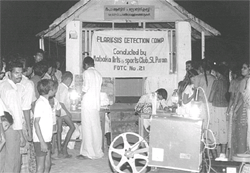Letting go a good thing
 the story of the fall and rise of filaria in Cherthala taluka of Alappuzha district, Kerala, represents all that is wrong with planning and management of public health in India. The field station of the Vector Control Research Centre ( vcrc ), set up in Cherthala by the Indian Council of Medical Research ( icmr ) to combat filaria, closed down in March 1998.
the story of the fall and rise of filaria in Cherthala taluka of Alappuzha district, Kerala, represents all that is wrong with planning and management of public health in India. The field station of the Vector Control Research Centre ( vcrc ), set up in Cherthala by the Indian Council of Medical Research ( icmr ) to combat filaria, closed down in March 1998.
During the 12 years that it functioned, vcrc 's relentless efforts in environmental management greatly reduced the incidence of the disease. But Pratibha Jayasimhan, vcrc research scientist in-charge of the Cherthala project has fears: "It may rear its head again.'
Filaria poses a grave threat to public health in India. According to the Central Bureau of Health Intelligence, New Delhi, there were 26.92 million carriers of the disease and 20.40 cases of full-blown filaria in 1994. Filaria connotes a group of vector-borne diseases of the tropics and is caused by infection with parasitic nematode worms transmitted by mosquitoes. In one of the forms of the disease, lymphatic filaria, which is common in India, the worms crowd the lymph vessels. There are two stages of lymphatic filaria. The first is microfilaria, the larval stage of the worm in which the blood of those infected swarms with the parasite, although there are no clinical symptoms. The second or chronic stage leads to elephantiasis
